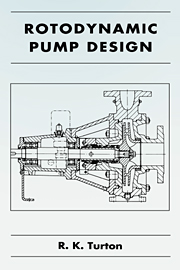Book contents
- Frontmatter
- Contents
- Preface
- Symbols
- 1 Fundamental principles
- 2 Cavitation in pumps
- 3 Centrifugal pump principles
- 4 Principles of axial and mixed flow pumps
- 5 Flow calculations in pumps and an introduction to computer aided techniques
- 6 Single stage centrifugal pump design
- 7 The design of axial and mixed flow pumps
- 8 Basic design principles of shafts, bearings and seals, and selection of drive
- 9 Pump design for difficult applications
- 10 An introduction to the next stage in the pump design process
- References
- Index
5 - Flow calculations in pumps and an introduction to computer aided techniques
Published online by Cambridge University Press: 29 September 2009
- Frontmatter
- Contents
- Preface
- Symbols
- 1 Fundamental principles
- 2 Cavitation in pumps
- 3 Centrifugal pump principles
- 4 Principles of axial and mixed flow pumps
- 5 Flow calculations in pumps and an introduction to computer aided techniques
- 6 Single stage centrifugal pump design
- 7 The design of axial and mixed flow pumps
- 8 Basic design principles of shafts, bearings and seals, and selection of drive
- 9 Pump design for difficult applications
- 10 An introduction to the next stage in the pump design process
- References
- Index
Summary
Introduction
In the study of fluid mechanics, Newton's second law of motion enables the Eulerian equations of motion of a fluid to be applied to a study of the forces acting on a fluid particle at a particular point at a particular time. The solution of these equations with the true boundary conditions in a pump is a formidable task, because within a pump there are rotating and stationary blades that change in their orientation and cross-sectional geometry from hub to tip. There also are boundary layers on the annulus walls and the blade surfaces, wakes from the trailing edges of the blade, over-tip leakage flows etc, so the flow is unsteady, three-dimensional, and viscous.
A brief reference has already been made to empirical approaches in the chapter on axial and mixed flow machines principles. In this chapter the empirical approach to determining passage shapes will first be outlined, and then the more analytical techniques made possible by the computer will be outlined.
Stream-surfaces
Where pumps are of radial, of Francis type or completely mixed flow layout, the principles for centrifugal pumps already covered are often used, once the stream-surfaces are established. In the following sections the approach to the shape of stream surfaces is discussed, and then empirical solutions are outlined.
Stream-surface design
Solutions are described in some detail in texts such as that by Wisclicenus (1965) and in less detail by Turton (1984a).
- Type
- Chapter
- Information
- Rotodynamic Pump Design , pp. 80 - 94Publisher: Cambridge University PressPrint publication year: 1994



